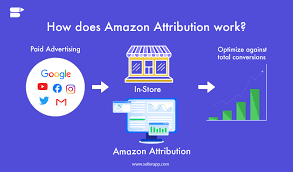Amazon Attribution vs Traditional Attribution: A Comparative Analysis

If you are a brand that sells products on Amazon, you might be wondering how to measure the effectiveness of your marketing campaigns across different channels. How do you know which of your ads, social media posts, emails, or other sources are driving traffic and conversions on Amazon? How do you optimize your budget and strategy based on data-driven insights?
This is where Amazon Attribution comes in. Amazon Attribution is a free solution for advertising and analytics measurement and it gives marketers insight into how their non-Amazon marketing channels achieve on Amazon. With Amazon Attribution, you can track and attribute conversions from search ads, social ads, display ads, video ads, and email marketing to your products and Store on Amazon. In this article, we will compare Amazon Attribution with traditional attribution methods and show you how it can help you grow your brand and sales on Amazon.
Contents
What is Traditional Attribution
Traditional attribution is the process of assigning credit or value to different marketing channels based on their contribution to a desired outcome, such as a sale or a lead. Traditional attribution methods have some limitations when it comes to measuring the impact of non-Amazon marketing channels on Amazon sales. For example:
- They do not account for the unique customer journey and behavior on Amazon, such as browsing, searching, adding to a cart, and purchasing.
- They do not provide granular and real-time data on how customers discover, research, and buy products on Amazon.
- They do not allow for in-flight optimization of non-Amazon campaigns based on Amazon conversion metrics.
What is Amazon Attribution
Amazon Attribution is a free solution for advertising and analytics measurement and it provides marketers with insight into how their non-Amazon marketing channels accomplish on Amazon. With Amazon Attribution, you can:
- Measure: Understand the impact of your cross-channel digital marketing activities on Amazon with metrics such as clicks, detail page views, add-to carts, and sales.
- Optimize: Make in-flight optimizations using on-demand advertising analytics to help maximize impact and ensure efficiency.
- Plan: Learn which of your strategies maximize return on investment and drive sales on Amazon to build future marketing plans.
Amazon Attribution works by generating unique tracking tags for each of your non-Amazon campaigns that drive to your products or Store on Amazon. These tags can then be implemented across your search ads, display ads, video ads, social ads, and email marketing. When customers click on these tagged links and land on Amazon, Amazon Attribution tracks their actions and attributes conversions to your campaigns. You can also use ACOS Amazon to assess the efficiency and profitability of your non-Amazon campaigns and plan your future marketing budget and goals.
How does Amazon Attribution compare with traditional attribution
Amazon Attribution differs from traditional attribution methods in several ways
- It focuses on measuring the performance of non-Amazon marketing channels that drive traffic and conversions on Amazon.
- It provides full-funnel advertising analytics with metrics that reflect the customer journey and behavior on Amazon.
- It allows for real-time reporting and optimization of non-Amazon campaigns based on Amazon conversion metrics.
- It is free and easy to use for eligible sellers enrolled in Amazon Brand Registry, vendors, KDP authors, and agencies with clients who sell products on Amazon.
What are the benefits of using Amazon Attribution
Using Amazon Attribution can help you
- Understand which non-Amazon strategies are helping you reach your goals on Amazon.
- Discover new sales opportunities by learning more about how shoppers engage with your brand and products on Amazon.
- Produce return on investment by making sure your marketing campaigns are creating value for your brand on Amazon.
How can you use ACOS Amazon to measure your campaign efficiency
ACOS Amazon stands for Advertising Cost of Sales, which is a metric that measures how efficiently your advertising spend generates sales on Amazon. It is calculated by dividing your total advertising spend by your total attributed sales. For example, if you spend $100 on advertising and generate $200 in sales, your ACOS Amazon is 50%.
ACOS Amazon can help you evaluate the profitability and return on investment of your non-Amazon campaigns measured by Amazon Attribution. A lower ACOS Amazon means that you are spending less to generate more sales, while a higher ACOS Amazon means that you are spending more to generate fewer sales.
You can use ACOS Amazon to compare the performance of different non-Amazon campaigns and channels and identify areas for improvement. You can also use ACOS Amazon to set goals and budgets for your non-Amazon campaigns based on your target profit margin and breakeven point.
Conclusion
Amazon Attribution is a powerful tool that allows you to measure and optimize the impact of your non-Amazon marketing campaigns on Amazon. By using Amazon Attribution, you can gain visibility into how customers discover, research, and buy your products on Amazon, and how you can improve your marketing strategies based on data-driven insights. You can also use ACOS Amazon to evaluate the efficiency and profitability of your non-Amazon campaigns and plan your future marketing budget and goals.






